The Aircraft Battery Market is estimated to be valued at USD 540.4 million in 2025 and is projected to reach USD 1850.7 million by 2035, registering a compound annual growth rate (CAGR) of 13.1% over the forecast period.
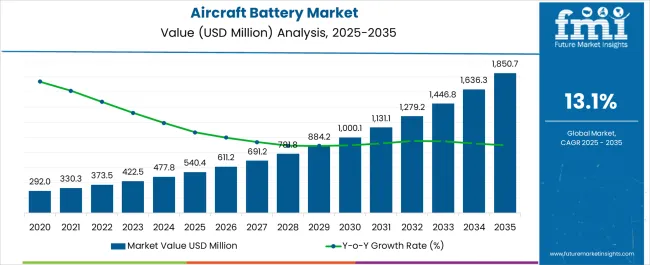
| Metric | Value |
|---|---|
| Aircraft Battery Market Estimated Value in (2025 E) | USD 540.4 million |
| Aircraft Battery Market Forecast Value in (2035 F) | USD 1850.7 million |
| Forecast CAGR (2025 to 2035) | 13.1% |
The Aircraft Battery market is expanding steadily, supported by the rising demand for efficient, lightweight, and high-performance energy storage systems in modern aviation. Growing aircraft production and increasing reliance on electrification for auxiliary power, emergency systems, and hybrid propulsion are driving adoption across both commercial and regional fleets. The industry is experiencing a strong shift toward sustainable aviation, which has intensified interest in advanced battery technologies that can support reduced emissions and improved fuel efficiency.
Integration of lithium-ion chemistry and smart battery management systems is enabling longer lifespans, faster charging, and higher energy density, which are essential for next-generation aircraft. Additionally, stringent aviation safety regulations and performance standards are reinforcing the need for reliable battery solutions that meet compliance requirements.
Growing air passenger traffic, particularly in emerging economies, is also encouraging fleet expansion and modernization, further boosting demand for aircraft batteries As airlines and manufacturers prioritize innovation, cost-efficiency, and regulatory compliance, the Aircraft Battery market is expected to witness sustained growth, with opportunities shaped by advancements in material science, hybrid-electric propulsion, and digital monitoring systems.
The aircraft battery market is segmented by sales channel, battery type, aircraft type, and geographic regions. By sales channel, aircraft battery market is divided into Aftermarket and OEM. In terms of battery type, aircraft battery market is classified into Lithium Ion Battery, Nickel Metal Hydride Battery, Nickel Cadmium Battery, Lead Acid Battery, and Others. Based on aircraft type, aircraft battery market is segmented into Regional Aircraft, Very Large Body Aircraft, Wide Body Aircraft, and Narrow Body Aircraft. Regionally, the aircraft battery industry is classified into North America, Latin America, Western Europe, Eastern Europe, Balkan & Baltic Countries, Russia & Belarus, Central Asia, East Asia, South Asia & Pacific, and the Middle East & Africa.
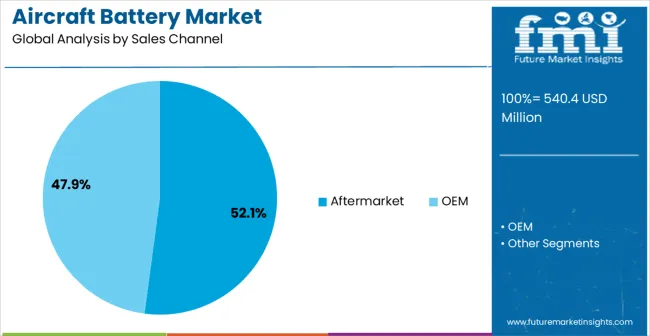
The aftermarket sales channel segment is projected to hold 52.1% of the market revenue in 2025, making it the leading distribution channel. Growth in this segment is being driven by the rising need for replacement and maintenance of batteries due to safety-critical requirements in aviation. Aircraft batteries undergo frequent testing and replacement cycles, ensuring compliance with aviation regulations and operational reliability.
Airlines and maintenance service providers increasingly rely on aftermarket suppliers for certified products, which guarantees airworthiness and performance standards. Strong demand for maintenance, repair, and overhaul services is further strengthening this segment, as airlines seek to reduce downtime while ensuring continuous operational safety. The widespread use of aftermarket batteries also provides cost-effective options for extending aircraft life cycles without significant capital expenditure.
As global fleets continue to grow and age simultaneously, aftermarket demand is expected to remain resilient, supported by regulatory mandates and safety-driven replacement needs The consistent requirement for quality-certified products ensures that the aftermarket will maintain its dominant position in the market.
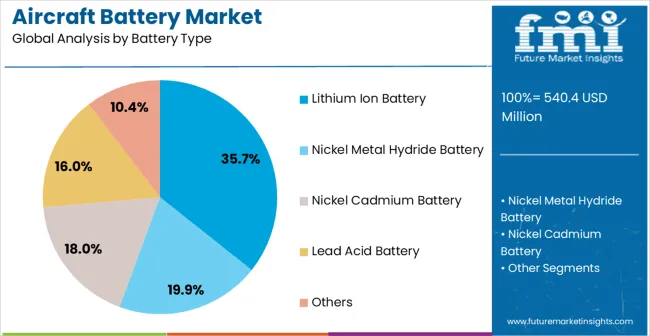
The lithium ion battery type segment is anticipated to account for 35.7% of the market revenue in 2025, positioning it as the leading battery type. This growth is being driven by the superior energy density, lightweight characteristics, and longer operational life of lithium ion batteries compared to traditional chemistries. Aircraft manufacturers are increasingly integrating these batteries to support advanced avionics, emergency systems, and auxiliary power requirements.
Lithium ion batteries also enable faster charging cycles, improved efficiency, and reduced maintenance, which are vital in high-performance aviation environments. The segment benefits from advancements in thermal management and safety technologies, which address concerns of overheating and reliability in demanding flight conditions. Their compatibility with hybrid-electric propulsion systems and alignment with sustainability initiatives further strengthen adoption.
As the aviation industry accelerates its shift toward electrification and lightweighting, lithium ion batteries are expected to consolidate their market leadership Continuous research and development investments in battery chemistries and safety innovations are likely to reinforce their dominance in the forecast period.
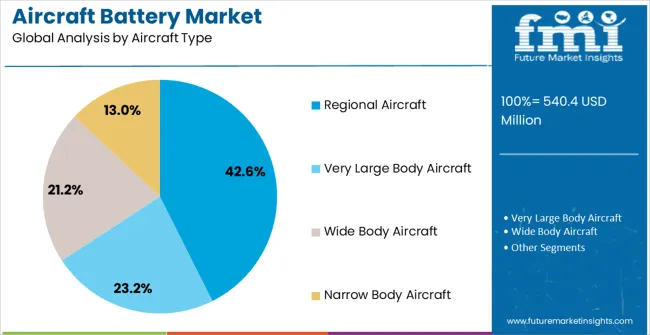
The regional aircraft type segment is expected to hold 42.6% of the market revenue in 2025, establishing itself as the leading aircraft category. This dominance is supported by the rising demand for regional air travel, driven by growing passenger traffic in emerging economies and increasing connectivity across short-haul routes. Regional aircraft require reliable, lightweight, and cost-efficient battery systems to support frequent flight cycles, making advanced battery technologies essential.
The adoption of lithium ion batteries in regional fleets is improving operational efficiency, reducing maintenance costs, and aligning with industry sustainability targets. Regional carriers are also prioritizing modern fleet upgrades, supported by government initiatives to enhance regional connectivity, which is further boosting battery demand.
The segment benefits from the shorter turnaround times and higher operational intensity of regional flights, where reliable battery performance is critical As regional aviation expands to meet growing passenger demand and environmental regulations, the adoption of advanced aircraft batteries in this category is expected to strengthen further, consolidating its leading market share position.
The global aviation industry is looking forward towards increasing development of robust and high density aircraft battery that would cater to the airplane battery pack power requirements. Aviation industry is witnessed to make a major shift towards MEA (more electric architecture) for improved and sustainable batteries, which in turn fuels the growth of the aircraft battery market.
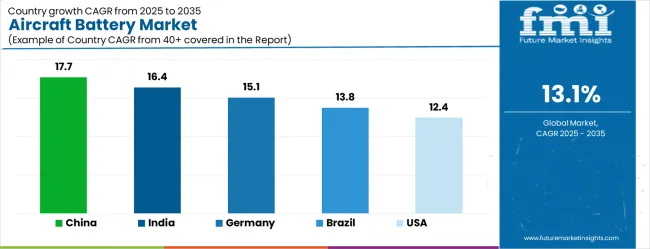
| Country | CAGR |
|---|---|
| China | 17.7% |
| India | 16.4% |
| Germany | 15.1% |
| Brazil | 13.8% |
| USA | 12.4% |
| UK | 11.1% |
| Japan | 9.8% |
The Aircraft Battery Market is expected to register a CAGR of 13.1% during the forecast period, exhibiting varied country level momentum. China leads with the highest CAGR of 17.7%, followed by India at 16.4%. Developed markets such as Germany, France, and the UK continue to expand steadily, while the USA is likely to grow at consistent rates. Japan posts the lowest CAGR at 9.8%, yet still underscores a broadly positive trajectory for the global Aircraft Battery Market. In 2024, Germany held a dominant revenue in the Western Europe market and is expected to grow with a CAGR of 15.1%. The USA Aircraft Battery Market is estimated to be valued at USD 199.7 million in 2025 and is anticipated to reach a valuation of USD 199.7 million by 2035. Sales are projected to rise at a CAGR of 0.0% over the forecast period between 2025 and 2035. While Japan and South Korea markets are estimated to be valued at USD 25.7 million and USD 14.7 million respectively in 2025.
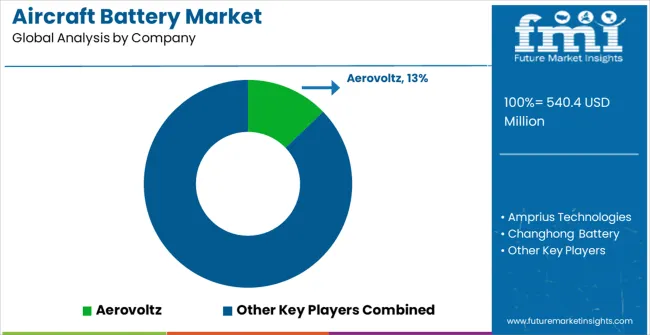
| Item | Value |
|---|---|
| Quantitative Units | USD 540.4 Million |
| Sales Channel | Aftermarket and OEM |
| Battery Type | Lithium Ion Battery, Nickel Metal Hydride Battery, Nickel Cadmium Battery, Lead Acid Battery, and Others |
| Aircraft Type | Regional Aircraft, Very Large Body Aircraft, Wide Body Aircraft, and Narrow Body Aircraft |
| Regions Covered | North America, Europe, Asia-Pacific, Latin America, Middle East & Africa |
| Country Covered | United States, Canada, Germany, France, United Kingdom, China, Japan, India, Brazil, South Africa |
| Key Companies Profiled | Aerovoltz, Amprius Technologies, Changhong Battery, Concorde Battery, EaglePicher Technologies, EnerSys, GS Yuasa, HBL Power Systems, Mid-Continent Instrument, Molicel, Parker-Meggitt, Saft, SolarEdge Technologies, Teledyne Technologies, and Tesla |
The global aircraft battery market is estimated to be valued at USD 540.4 million in 2025.
The market size for the aircraft battery market is projected to reach USD 1,850.7 million by 2035.
The aircraft battery market is expected to grow at a 13.1% CAGR between 2025 and 2035.
The key product types in aircraft battery market are aftermarket and oem.
In terms of battery type, lithium ion battery segment to command 35.7% share in the aircraft battery market in 2025.






Our Research Products

The "Full Research Suite" delivers actionable market intel, deep dives on markets or technologies, so clients act faster, cut risk, and unlock growth.

The Leaderboard benchmarks and ranks top vendors, classifying them as Established Leaders, Leading Challengers, or Disruptors & Challengers.

Locates where complements amplify value and substitutes erode it, forecasting net impact by horizon

We deliver granular, decision-grade intel: market sizing, 5-year forecasts, pricing, adoption, usage, revenue, and operational KPIs—plus competitor tracking, regulation, and value chains—across 60 countries broadly.

Spot the shifts before they hit your P&L. We track inflection points, adoption curves, pricing moves, and ecosystem plays to show where demand is heading, why it is changing, and what to do next across high-growth markets and disruptive tech

Real-time reads of user behavior. We track shifting priorities, perceptions of today’s and next-gen services, and provider experience, then pace how fast tech moves from trial to adoption, blending buyer, consumer, and channel inputs with social signals (#WhySwitch, #UX).

Partner with our analyst team to build a custom report designed around your business priorities. From analysing market trends to assessing competitors or crafting bespoke datasets, we tailor insights to your needs.
Supplier Intelligence
Discovery & Profiling
Capacity & Footprint
Performance & Risk
Compliance & Governance
Commercial Readiness
Who Supplies Whom
Scorecards & Shortlists
Playbooks & Docs
Category Intelligence
Definition & Scope
Demand & Use Cases
Cost Drivers
Market Structure
Supply Chain Map
Trade & Policy
Operating Norms
Deliverables
Buyer Intelligence
Account Basics
Spend & Scope
Procurement Model
Vendor Requirements
Terms & Policies
Entry Strategy
Pain Points & Triggers
Outputs
Pricing Analysis
Benchmarks
Trends
Should-Cost
Indexation
Landed Cost
Commercial Terms
Deliverables
Brand Analysis
Positioning & Value Prop
Share & Presence
Customer Evidence
Go-to-Market
Digital & Reputation
Compliance & Trust
KPIs & Gaps
Outputs
Full Research Suite comprises of:
Market outlook & trends analysis
Interviews & case studies
Strategic recommendations
Vendor profiles & capabilities analysis
5-year forecasts
8 regions and 60+ country-level data splits
Market segment data splits
12 months of continuous data updates
DELIVERED AS:
PDF EXCEL ONLINE
Aircraft Cabin Environment Sensor Market Forecast and Outlook 2025 to 2035
Aircraft Flight Control System Market Size and Share Forecast Outlook 2025 to 2035
Aircraft Electric Motor Market Forecast Outlook 2025 to 2035
Battery Operated Light Market Forecast and Outlook 2025 to 2035
Aircraft Cooling Turbines Market Size and Share Forecast Outlook 2025 to 2035
Aircraft Smoke Detection and Fire Extinguishing System Market Size and Share Forecast Outlook 2025 to 2035
Aircraft Hose Fittings Market Size and Share Forecast Outlook 2025 to 2035
Aircraft Cabin Interior Market Size and Share Forecast Outlook 2025 to 2035
Aircraft Galley Systems Market Size and Share Forecast Outlook 2025 to 2035
Aircraft Interior Lighting Market Size and Share Forecast Outlook 2025 to 2035
Aircraft Floor Panels Market Size and Share Forecast Outlook 2025 to 2035
Aircraft Fuel Systems Market Size and Share Forecast Outlook 2025 to 2035
Aircraft Lubricant Market Size and Share Forecast Outlook 2025 to 2035
Aircraft Seat Market Size and Share Forecast Outlook 2025 to 2035
Aircraft Ground Support Equipment Market Size and Share Forecast Outlook 2025 to 2035
Aircraft Maintenance, Repair and Overhaul Market Size and Share Forecast Outlook 2025 to 2035
Aircraft Actuators Market Size and Share Forecast Outlook 2025 to 2035
Battery Voltage Recorder Market Size and Share Forecast Outlook 2025 to 2035
Battery Resistance Tester Market Size and Share Forecast Outlook 2025 to 2035
Aircraft Elevator Market Size and Share Forecast Outlook 2025 to 2035

Thank you!
You will receive an email from our Business Development Manager. Please be sure to check your SPAM/JUNK folder too.
Chat With
MaRIA